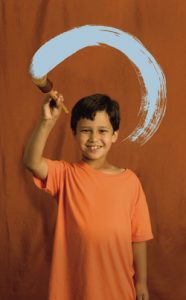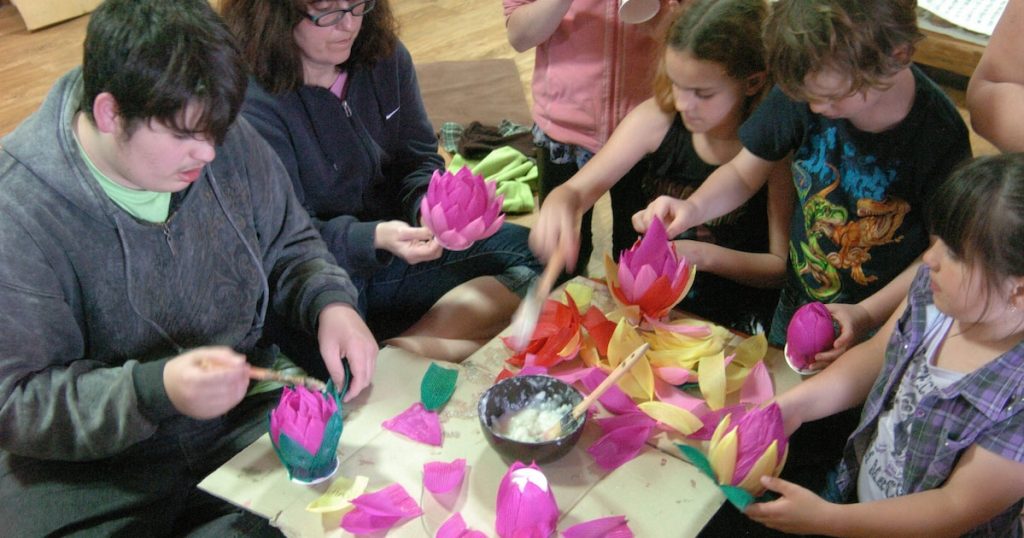Of all the thousands of the Buddha’s teachings, he directed a very few—three or four, depending on what you count—specifically to children. Considering the multitude and breadth of his suttas, it’s hard to imagine why more weren’t geared to kids: was it because following his path requires a mature mind and mature commitment? Or was it because Indian society twenty-six hundred years ago had the instruction of children firmly in household hand—if adult family members were following the Buddha, children would naturally absorb the lessons and culture of the dharma, too. Or perhaps—and this is a personal guess—it was because the Buddha’s principal teaching to a child so perfectly encapsulated the dharma that little else needed to be said. Was he doing what the most effective parents and teachers do—paring down a complicated set of ideas to its most profound, most pressing—and illustrating the lesson in such a way that a child can connect it to his or her own life?
The child in question here was his own son, Rahula—Pali for “fetter” or “shackle.” The Buddha is famous with Western practitioners for having abandoned his family on the day of his only child’s birth—what kind of father would do such a thing? (We all know a few.) But in the Buddha’s case, renunciation of fatherhood and royal existence represented his profound conviction that a lasting, unconditioned happiness could be found—and in leaving behind his family, the fetters on his emotional and spiritual life, he could ultimately give back to them the possibility of the same deathless happiness he would find for himself.
When Rahula was seven years old, he became his father’s disciple and began his training as a monk. In a discourse that has come to be known as the “Rahula Sutta” (Majjhima Nikaya 61), the Buddha instructed his young son with the seeds of some of his most important teachings. He started out by stressing the magnitude of being truthful—implying that if Rahula wanted to find the truth, he would first have to be truthful to himself. He then talked about using one’s actions as a mirror. Before you do anything, he told Rahula, ask yourself: Is what I intend to do here skillful or unskillful? Will it lead to well-being or harm? If it looks harmful, don’t do it. If it looks okay, go ahead and give it a try. While doing it, though, ask the same questions. If it turns out that it’s causing harm, stop. If not, continue with it. Then after you’ve done it, ask the same questions—Did it bring about well-being or harm? If you see that what originally looked okay actually ended up being harmful, talk it over with someone else on the path and resolve never to make that mistake again. But if, as the Buddha put it, “on reflection [of a bodily, verbal, or mental action], you know that it did not lead to affliction…it was a skillful action with pleasant consequences, pleasant results, then you should stay mentally refreshed and joyful, training day and night in skillful mental qualities.”

The Buddha was instructing his son in the importance of learning from his mistakes, of taking responsibility for his own actions, and of cultivating compassion. But just as crucially, he was teaching his son about the role of intention in our actions and the way causality works—with actions bringing about immediate results as well as long-term results. He was also teaching the basis for the Four Noble Truths: the notion that suffering is caused by past and present actions, and that if we’re observant we can discover how to act more and more skillfully to a point of total freedom.
The Buddha had a leg up on instructing children in that he lived in a world where spiritual practice and instruction were a part of daily life. For those of us who have charged ourselves with the teaching, and raising, of kids, and want to do it inculcating Buddhist values, we must build what doesn’t exist—a support structure for teaching the dharma to young people. We don’t have to do it from scratch—the Rahula Suttaand many other teachings are an extraordinary place to start, and our own experience and conviction counts for a lot—but much scaffolding needs to be put in place, too. Interesting stories and activities can allow children to see the relevance of the teachings, while adults, friends, and community members can bring their experiences, insights, and skills to teaching meditation and helping children along the path.
The late H. Stephen Glenn, a wonderful educator and writer of parenting books such as Raising Self-Reliant Children in a Self-Indulgent World, often spoke of how contemporary Western parents are pioneers but without the benefit of basic pioneer skills. For thousands of years, parents and teachers learned the art of raising children from elders, family members, and neighbors who lived together under relatively stable circumstances for generations. Pilgrims who uprooted their families traveled together and settled new communities with common values and goals. They sat around campfires and shared problems and strategies, so everyone didn’t have to flounder learning the same lessons in isolation.
But after World War II, an entire set of cultural traditions was disrupted. The combined effects of industrialization, returning veterans, the Depression and exploding technology pushed young families to a new lifestyle frontier without the accumulated wisdom gained from networks and support systems to guide them. “Parenting,” wrote Glenn, “which was once the cumulative work of generations, became a grim, part time struggle for two (or more)”—or fewer—”relatives who did not have much experience in what they were trying to do.” In many ways, we are still living on that frontier, making up our parenting strategies as we go along, with little support or wisdom save that gleaned from “experts.”
As Buddhists, we are pioneers, too, attempting to build a religious and ethical culture for ourselves and our children, in a materialistic world that has no use for our vision. But the beauty of teaching dharma to children is that it forces us to be skillful pioneers. In some ways, it feels as if incorporating children (and other human realities) into Buddhist practice is the last frontier for most practice centers, modeled as they are on a rarified, monastery-inspired retreat model (which, incidentally, is a specialized activity even in Buddhist countries). It’s not a matter of hiring a babysitter while we meditate, although organizing effective and economical childcare—never mind teaching dharma to kids—is an enormous, time-intensive task. Being around us when we practice might expose our kids to what we do, but there’s not much in it for them.
Creating a Buddhist life for our kids means that we rejigger our approach to parenting, or we become big time volunteers, researching teaching methods, setting up programs, making paper Vesak lanterns and prayer flags with eight-year-olds, teaching meditation in schools. It can be incredibly frustrating. When Willa, my daughter, was eight, we traveled to a monastery to visit a friend; afterward, she said, “Why would I want to be a Buddhist? It’s so boring and ugly.” Read: there’s nothing for kids to do, there’s nothing fluffy or pink about it, and I need to reject this thing you hold so dear. A year later, though, she began engaging me in a series of conversations about the relationship between karma and luck. Her verdict was that you could believe in both: “You make your own karma, and you make your own luck, so luck must be part of your karma.” I also have the great boon of working at a school with a meditation program for kids (see “Tough Lovingkindness,” page 74) so she receives some training without the baggage of having to get it from her parents, and can test its value for herself.
The wonderful part of this project is that we are restoking the pioneer campfire and at the same time taking our cues from our children. We model generosity, we emphasize the importance of sticking with a task such as paying attention, or sitting in meditation, until it becomes a skill we’re really good at—because that’s when it’s most pleasurable and meaningful and bears fruit. We are beefing up our own practice in the process, but the point here is that we are giving something really valuable to our children. In the Rahula Sutta, the Buddha guides his son to cultivate friendships with wise adults who can help him make good choices—people in whom he can trust and confide. If we can position ourselves to be those friends to children—our own or other people’s—we are providing a great service. The neuro-developmentalist and pediatrician Mel Levine, who has written many books about child development in the U.S. Today, believes we live in the first-ever historical period when children look more to their peers and the media for their social cues than to their elders. If we don’t want Hannah Montana and Iron Man serving as our kids’ only role models, we need to earn and maintain their respect.
This special section is meant to be a sampling of how Buddhists in the U.S. Are teaching dharma to children, and to offer some inspiration and resources to those of us who want to create or access a Buddhist religious education that is germane to kids and authentic. The world of a child usually spans three spheres: home, school, and adults around him, and so the articles that follow focus on teaching kids—from preschool up to adolescence—in those areas. We chose to focus on the early and middle years of childhood because working with teens and young adults brings in other deep issues that deserve more attention than we can give here.
There are many, many beautifully designed dharma programs for kids at practice centers around the country—Shambhala, San Francisco Zen Center, Spirit Rock, Sokka Gakkai International, and Jodo Shinshu are all organizations that for decades have supported parents and offered instruction for children. The Dharma Rain Zen Center in Portland, Oregon, is another one, and its founders write about the road to building a dharma school. Peter Doobinin, the guiding teacher of New York City’s Downtown Meditation Community, describes the meditation program he created in two public schools; and practitioners Tom Felt and Keith Platt share some of their approaches to parenting their twin girls at home and beyond. Finally, we offer some favorite books—reviewed for Tricycle by ten-year-old Olivia Dontsov, a New York City fifth grader—and aselection of websites, teaching resources, and other tools that we hope will kindle the campfire where it’s needed.
Thank you for subscribing to Tricycle! As a nonprofit, we depend on readers like you to keep Buddhist teachings and practices widely available.
